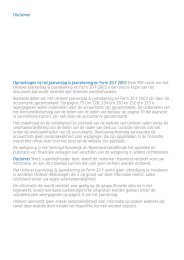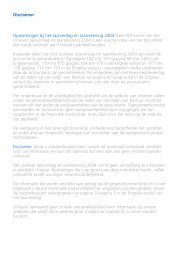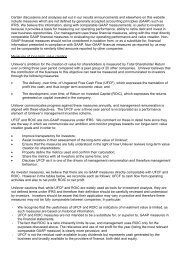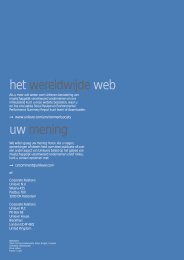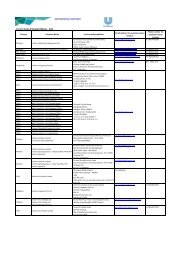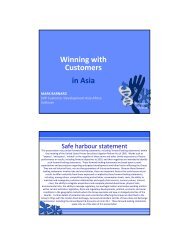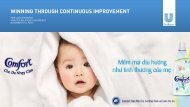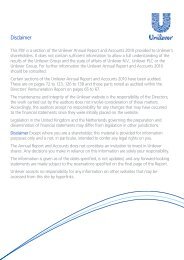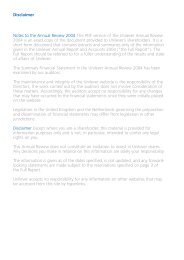Unilever Sustainable Living Plan Progress Report 2011
Unilever Sustainable Living Plan Progress Report 2011
Unilever Sustainable Living Plan Progress Report 2011
Create successful ePaper yourself
Turn your PDF publications into a flip-book with our unique Google optimized e-Paper software.
18 <strong>Unilever</strong> <strong>Sustainable</strong> <strong>Living</strong> <strong>Plan</strong> <strong>Progress</strong> <strong>Report</strong> <strong>2011</strong><br />
3.0<br />
OUR COMMITMENT<br />
l 0 AcHIEVED l 8 on-PLAn l 1 oFF-PLAn l 0 MISSED<br />
Source for Footprint and pie charts: <strong>Unilever</strong> 2008 baseline study across 14 countries.<br />
Total in tonnes.<br />
oUr aPProach<br />
climate change will have a growing impact<br />
on <strong>Unilever</strong>’s business. our suppliers of<br />
agricultural raw materials will be affected by<br />
changing weather patterns. our consumers<br />
will have to adapt to a world of rising food and<br />
energy prices and communities risk being<br />
displaced by extreme weather events such<br />
as floods and droughts.<br />
It is a particularly urgent issue for <strong>Unilever</strong> since<br />
the countries that are expected to feel the effects<br />
most severely are the developing economies that<br />
generate more than half our sales.<br />
We have calculated the greenhouse gas<br />
emissions across the lifecycle of over 1,600<br />
representative products in 14 countries.<br />
The calculation covers 70% of our volumes.<br />
From this we know that our largest greenhouse<br />
gas impacts are beyond our factory gates. The<br />
sourcing of raw materials and the use of our<br />
products by people at home account for more<br />
than 90%.<br />
We have set greenhouse gas reduction targets<br />
across our value chain – from sourcing,<br />
manufacturing, transport and refrigeration<br />
all the way through to consumer use of our<br />
products. To achieve these targets we need to<br />
work with our suppliers as well as offer new<br />
products that can help people reduce their<br />
own impacts.<br />
Halve the greenhouse gas impact of our products across the lifecycle by 2020.*<br />
OUR PERFORMANCE<br />
Given the complexity of calculating the lifecycle<br />
impacts of our product portfolio, we are investing<br />
in an automated process to allow us to measure<br />
progress regularly.<br />
An interim sample of 2010 data shows that<br />
our greenhouse gas footprint has remained<br />
broadly unchanged.<br />
OUR FOOTPRINT<br />
WHAT MATTERS MOST<br />
Reducing greenhouse gas emissions from heated<br />
water for showering and washing hair.<br />
26% 3%<br />
2% 68% 1%<br />
+<br />
+ +<br />
+<br />
Raw materials Manufacture Transport Consumer use Disposal<br />
* Throughout this document our environmental targets are expressed against a baseline<br />
of 2008 and on a ‘per consumer use’ basis. This means a single use, portion or serving<br />
of a product (see page 41).<br />
+



